This Will Make You Rethink Your Dividend Investing Strategy
Despite the popularity of using dividend yields to choose stocks for their retirement portfolios, there's a better indicator that investors should be looking at.


In the current interest rate environment, individual investors are understandably on the hunt for income. Naturally, many of them turn to dividend investing to generate a steady stream of income, especially in retirement.
However, the problem is that the way most people approach dividend investing is to fall into the yield trap. A stock that pays an above-average yield seems attractive and presumably solves the income problem. But does it?
Focusing on stocks that pay the highest current dividend yield is akin to telling a teenager to drop out of school to work flipping burgers so they can earn an income at that point in time. Wouldn’t they be better off INVESTING in their FUTURE so their income has the greatest potential to grow?

Sign up for Kiplinger’s Free E-Newsletters
Profit and prosper with the best of expert advice on investing, taxes, retirement, personal finance and more - straight to your e-mail.
Profit and prosper with the best of expert advice - straight to your e-mail.
The fact is that dividend-paying companies produce three, not two forms of return: stock price appreciation, current dividend yield, and something else far more valuable but often overlooked: the possibility of future dividend growth.
Current yields are tempting and could produce income streams in the short-term, but it’s not sustainable.
This is not an opinion, but rather a proven fact. To wit, my colleagues and I at Reality Shares looked at Bloomberg data, between 1992 and 2016 and found, on average, the companies with the highest dividend yields historically underperformed the broad equity market on a total return basis. Conversely, companies with the lowest dividend yields historically outperformed the broad equity market.
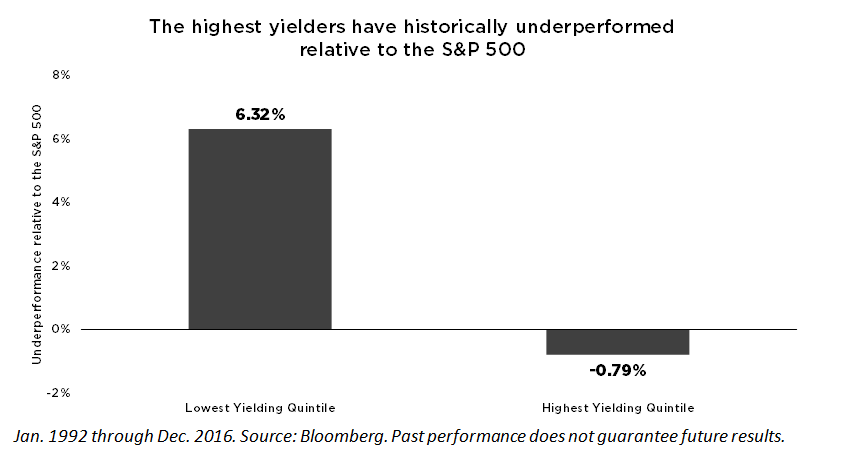
Certainly, this data is not meant to discourage you from dividend investing, but rather, it should make you rethink your dividend investing strategy. As the following chart shows, nearly 40% of the total return of the S&P 500 can be attributed to reinvested dividends and the power of compounding.
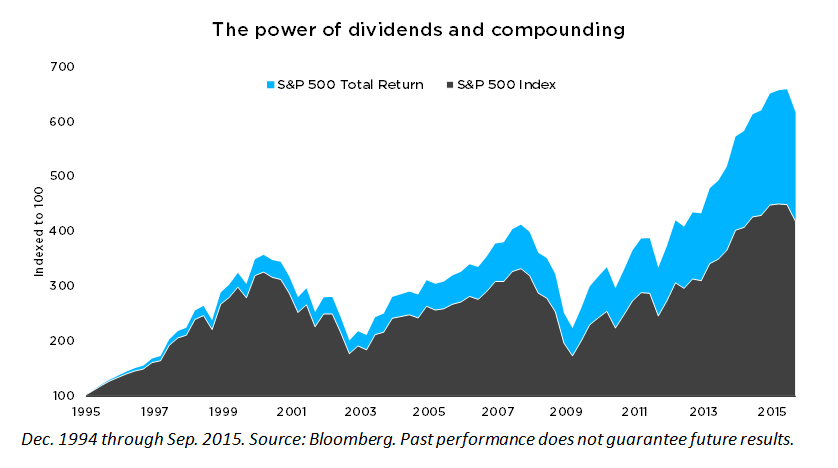
This is not just a domestic phenomenon. MSCI research found dividends were the largest contributor to global equity returns, accounting for 93% of total return over the 20-year period from December 1994 through September 2015.
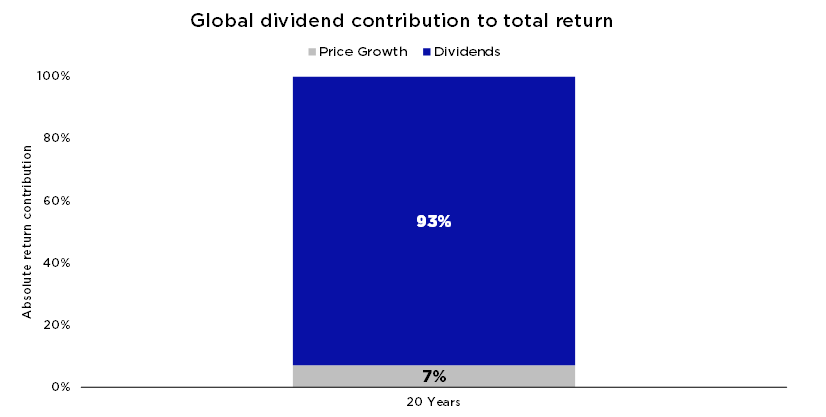
Dec. 1994 through Sep. 2015. Source: MSCI. Past performance does not guarantee future results.
If you break it down further, dividend yield accounted for only 29% of total return, whereas the growth of dividends represented nearly 65% of the performance over 20 years.
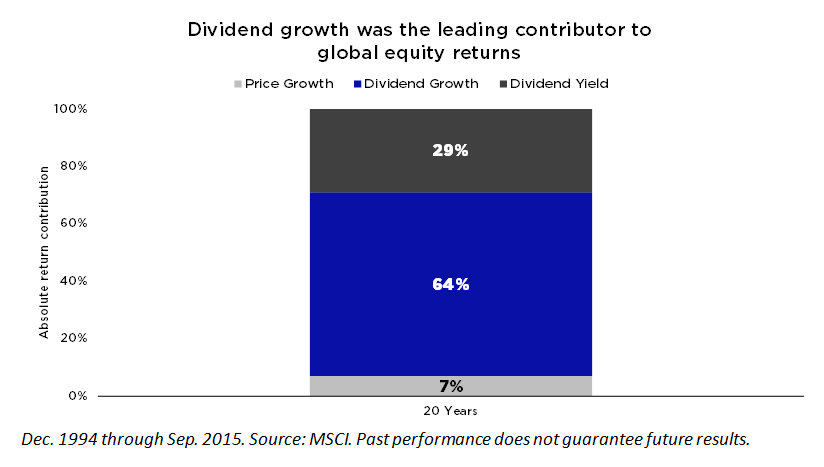
Go for the Dividend Growth
While the allure of a high-yielding stock can be attractive, investors need to remain disciplined and should instead focus on the stocks that are committed to growing dividends. Not only has the dividend growth component contributed significantly to historical total returns, but further research from Ned Davis confirms dividend growers and initiators have historically outperformed all other categories of stocks (over a span of 40+ years).

So, what is going on here? Remember what Albert Einstein said about the power of compounding: “Compound interest is the eighth wonder of the world. He who understands it earns it . . . he who doesn't . . . pays it. Compound interest is the most powerful force in the universe.” This is the key to unlocking the magic.
But here’s what even the most ardent dividend growth investors get wrong ...
In This Case, Size Really Does Matter
The magnitude of dividend growth actually matters even more so than whether or not a stock grows its dividend. Even among all the brilliant dividend-focused investors, most people miss this. Instead of simply being satisfied with companies that grow dividends, investors should be asking how much they grow dividends.
Companies that grew their dividends the most historically outperformed the broad equity market, and those companies with little to no dividend growth actually underperformed the broad equity market (on a total return basis). The following chart illustrates how the stocks with the highest dividend growth rates have historically outperformed the S&P 500 by nearly 9%, and it emphasizes the relevance of the level of dividend growth.
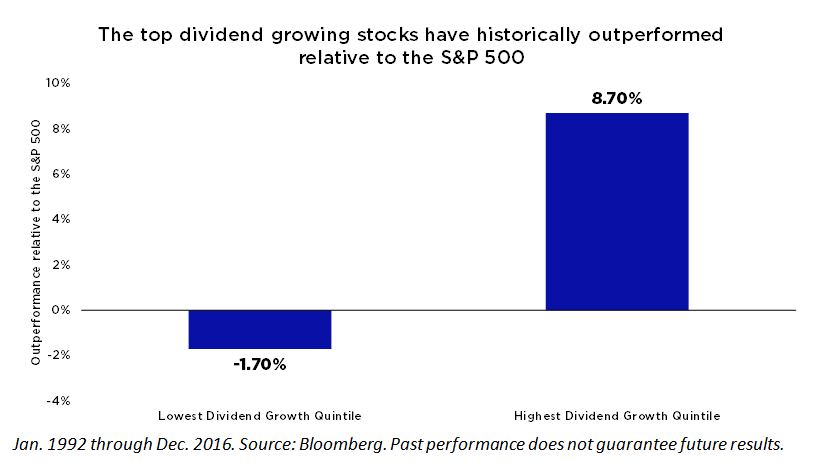
Remember that investing, for the most part, is all about the long term. Therefore, don’t worry about the low current income, and instead focus on companies that have the highest potential to grow their dividends in the future.
Dividend growth investing has historically offered investors an opportunity to outperform the market with lower volatility. Despite the popularity of dividend yield, dividend growth has been a better indicator of outperformance relative to the broad equity market, and the magnitude of dividend growth should be considered as part of a dividend investment strategy.
After running the dividend analysis numbers, here are the companies we believe are poised to raised their dividends the most (according to in-house research and our proprietary methodology, DIVCON):
Click here to find out how you can identify the leading dividend growth stocks for your portfolio.
Visit www.realityshares.com for important disclosures.
Get Kiplinger Today newsletter — free
Profit and prosper with the best of Kiplinger's advice on investing, taxes, retirement, personal finance and much more. Delivered daily. Enter your email in the box and click Sign Me Up.

Eric Ervin founded Reality Shares, a firm known for ETF industry innovation. He led the launch of investment analytics tools, including Blockchain Score™, a blockchain company evaluation system; DIVCON®, a dividend health analysis system; and the Guard Indicator, a directional market indicator. These tools were designed to help investors access innovative investment strategies as well as provide alternative dividend investment solutions to manage risk.
-
 Vaccines Medicare Covers for Free
Vaccines Medicare Covers for FreeThe U.S. is experiencing an outbreak of measles and is on track to have the most whooping cough cases since 1948; these vaccines Medicare covers for free can keep you safe.
By Donna LeValley
-
 Why You Need a Trusted Contact for Your Brokerage
Why You Need a Trusted Contact for Your BrokerageYour brokerage or bank needs someone to reach out to if it's concerned you're experiencing fraud or cognitive decline. That's where a trusted contact can help.
By John Waggoner
-
 Four Takeaways From Filing Your Taxes to Boost Your Financial Future
Four Takeaways From Filing Your Taxes to Boost Your Financial FutureNow that another tax season is in the rearview mirror for most of us, what lessons can you take from what you learned about your finances to plan for the future?
By Kate Winget
-
 What Claims Adjusters Are Thinking vs What They're Saying
What Claims Adjusters Are Thinking vs What They're SayingAfter a natural disaster, few of us are at our best, but here's what to keep in mind when you're interacting with your insurance company's claims adjuster.
By Karl Susman, CPCU, LUTCF, CIC, CSFP, CFS, CPIA, AAI-M, PLCS
-
 Looking to Make a Job Change? How to Stand Out Like a Pro
Looking to Make a Job Change? How to Stand Out Like a ProTo make a strong first impression in interviews or when networking, skip your job title and work history and use an opening gambit that highlights your talents.
By Anne deBruin Sample, CEO
-
 Stock Market Today: No 'Powell Put'? No Problem
Stock Market Today: No 'Powell Put'? No ProblemInvestors, traders and speculators look beyond both another Trump post and more signs of slowing economic activity.
By David Dittman
-
 First 100 Days: Trump's Impact on Your Finances
First 100 Days: Trump's Impact on Your FinancesHere are some opportunities to consider regarding investing, interest rates and tax cuts as the financial landscape shifts under the new administration.
By Daniel Razvi, Esquire
-
 What Would Happen if You Put Your Tax Refund in an IRA?
What Would Happen if You Put Your Tax Refund in an IRA?Not only could you get a tax break, but the compounding effect over 35 years could turn the average refund into nearly $14,000.
By Romi Savova
-
 Children Can't Afford to Fly the Nest? Here's How to Help
Children Can't Afford to Fly the Nest? Here's How to HelpThe high cost of living means more adult children are staying at home. Here are four ways to help financially so they can eventually spread their wings.
By Kelli Kiemle, AIF®
-
 Stock Market Today: Dow Drops 699 Points After Powell Speech
Stock Market Today: Dow Drops 699 Points After Powell SpeechFed Chair Powell warned of a slowing economy and higher inflation but said the central bank isn't ready to cut rates just yet.
By Karee Venema